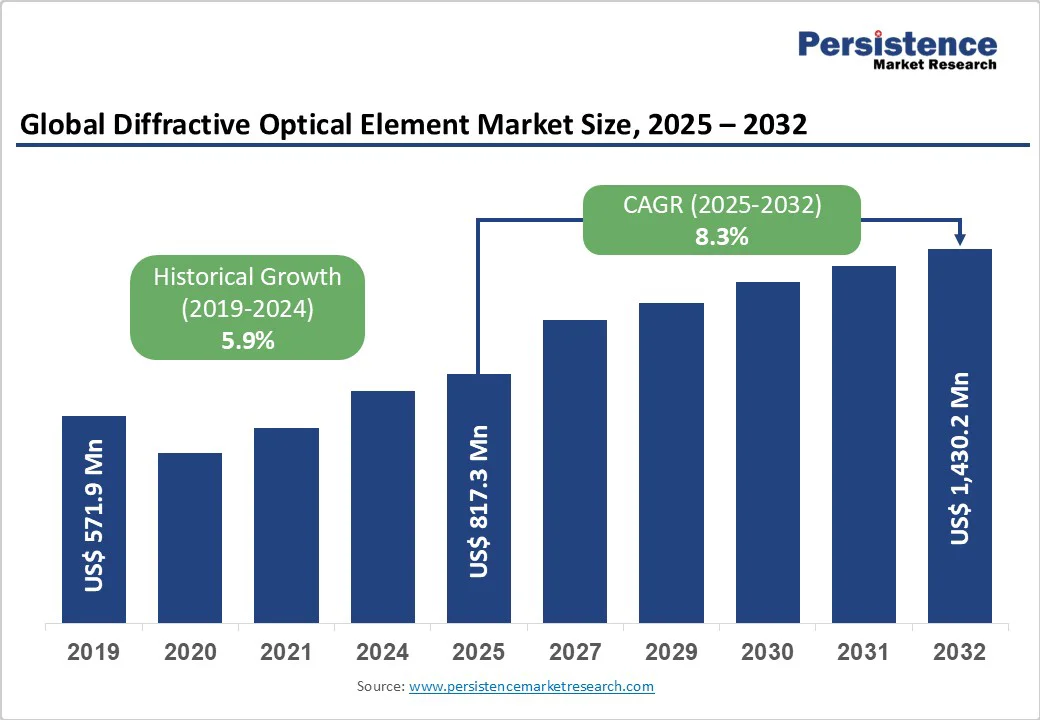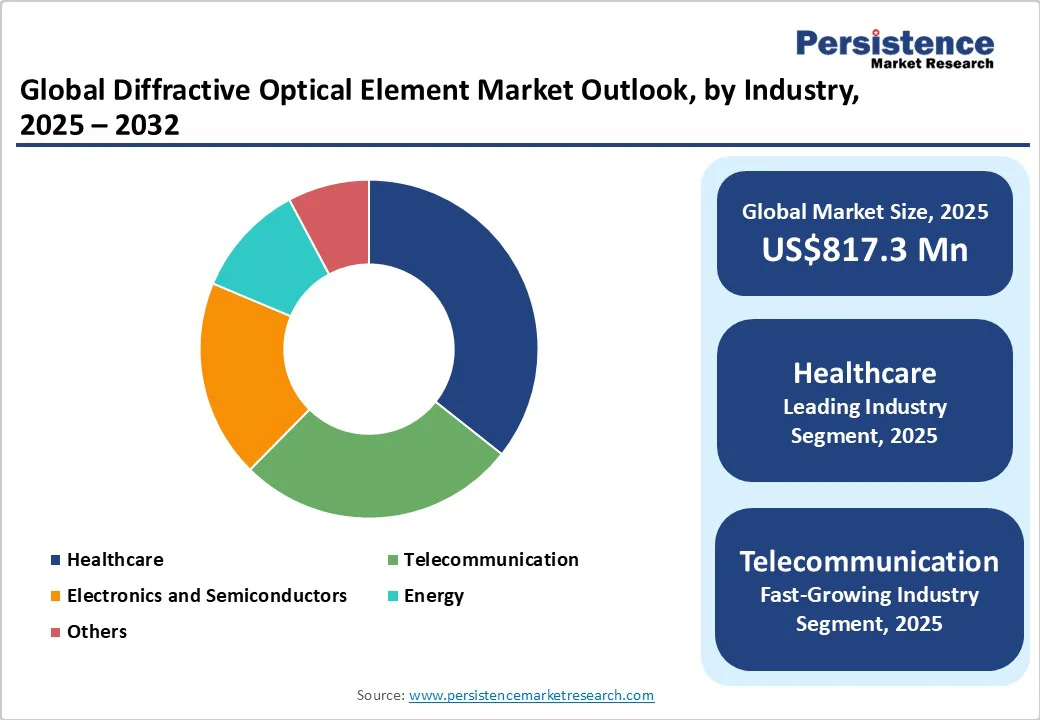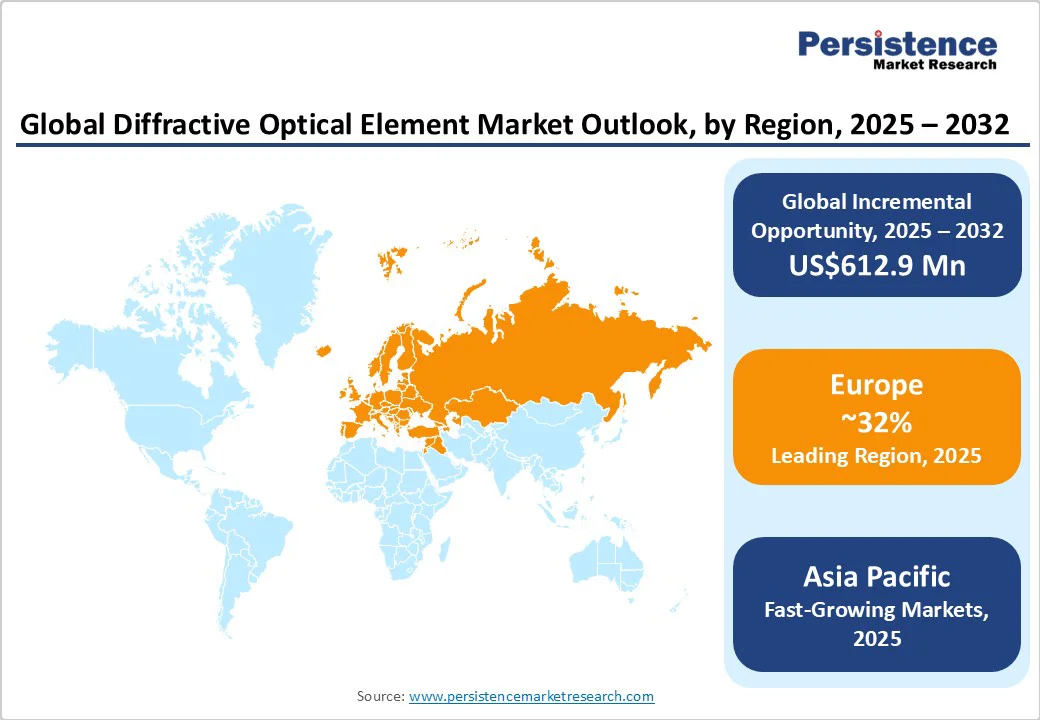ID: PMRREP14389| 198 Pages | 3 Oct 2025 | Format: PDF, Excel, PPT* | Semiconductor Electronics

The global diffractive optical element (DOE) market size is likely to value US$817.3 Mn in 2025 to US$1,430.2 Mn by 2032, growing at a CAGR of 8.3% during the forecast period from 2025 to 2032. The miniaturization of optical systems and the rising demand for compact, energy-efficient solutions are fueling the adoption of DOEs. Advancements in nanofabrication and optical design are increasing their precision, versatility, and accessibility. The growing need for high-performance optical solutions in emerging applications is driving sustained market growth.
| Key Insights | Details |
|---|---|
|
Diffractive Optical Element Market Size (2025E) |
US$817.3 Mn |
|
Market Value Forecast (2032F) |
US$1,430.2 Mn |
|
Projected Growth (CAGR 2025 to 2032) |
8.3% |
|
Historical Market Growth (CAGR 2019 to 2024) |
5.9% |

Compact optical systems in consumer electronics, medical devices, and aerospace are increasingly adopting diffractive optical elements to achieve precise light manipulation in smaller, lightweight designs. By replacing bulky lens assemblies, DOEs help reduce size, weight, and power consumption while maintaining high performance in applications such as LiDAR, laser projectors, and advanced imaging systems. Ongoing nanofabrication advancements allow for finer DOE structures, improving optical efficiency and expanding their use across industries. For instance, the U.S. National Nanotechnology Initiative (NNI) allocated $2.16 billion in 2024 to support innovations in compact optical technologies, highlighting DOEs as a critical enabler of next-generation miniaturized devices.
High-speed fiber-optic networks increasingly depend on DOEs for precise beam shaping and splitting to enhance signal quality and minimize data loss. The rapid adoption of 5G, cloud computing, and edge computing drives demand for compact, high-precision optical components that support higher bandwidth and lower latency. Data centers with dense interconnects rely on DOE-based solutions to optimize space, energy efficiency, and performance, while LiDAR integration in network monitoring further expands applications. According to Ericsson, global mobile data traffic is set to exceed 280 EB/month by 2030 (430 EB/month including FWA), with 5G rising from 35% in 2024 to 80% by 2030, directly fueling DOE adoption in telecommunications.
Diffractive optical element manufacturing involves advanced nanolithography and precision molding, requiring significant capital investment, specialized cleanroom facilities, and skilled technicians. High initial tooling and metrology costs restrict adoption in low-volume or price-sensitive applications, keeping production concentrated among established players. The wavelength-specific design of DOEs demands specialized optical expertise and requires system redesigns for integration, while temperature sensitivity and environmental stability concerns further limit application scope, slowing adoption and extending development timelines.
Diffractive optical elements (DOEs) are becoming essential in LiDAR systems and advanced driver-assistance systems (ADAS) for autonomous and electric vehicles. By enabling compact, high-precision, and cost-effective optical sensors, DOEs improve resolution, range, and efficiency, enhancing vehicle safety and intelligence. The growing adoption of electric and autonomous vehicles is increasing the optical component content per vehicle, prompting automakers to invest in miniaturized DOE solutions for aesthetic integration and mass-market deployment. These technologies are key to meeting stringent automotive standards while supporting next-generation vehicle sensing systems. For instance, the National Highway Traffic Safety Administration (NHTSA) allocated an additional $25.7 million in 2024 for research, rulemaking, and enforcement activities to translate automation technology into safety improvements.
Consumer electronics manufacturers are increasingly adopting diffractive optical elements (DOEs) in AR/VR devices for facial recognition, gesture control, and immersive display applications. For instance, Apple’s TrueDepth camera uses an Active DOE to project over 30,000 infrared dots for precise 3D face mapping. DOEs enable ultra-compact, high-performance light shaping, essential for realistic depth cues in gaming, industrial training, and remote collaboration. Their miniaturization capabilities support wearable devices, accelerate product development cycles, and benefit from high-volume manufacturing economies. As AR/VR adoption grows, DOEs are poised to see significant demand as a critical enabling technology in next-generation consumer electronics.
Beam splitters are expected to account for more than 52% share in 2025 as they are essential for dividing and directing light with high precision. They support accurate signal routing, power balancing, and wavelength separation, which are fundamental for advanced optical systems. The rising need for compact, efficient, and multifunctional components enhances their adoption. Their versatility in handling multiple light paths makes them the most widely used solution among diffractive elements.
Beam shapers are expected to grow at the highest rate due to the rising demand for precise beam profiling in various applications. Industries increasingly require uniform intensity distribution and high accuracy for microfabrication, lithography, and laser surgery. The shift toward miniaturization of electronic components and higher efficiency in laser systems further drives adoption. The growing use of high-power lasers in industrial and biomedical fields strengthens the need for advanced beam shaping solutions.
Biomedical devices are expected to account for more than 27% share in 2025 due to rising demand for precision optics in imaging, diagnostics, and minimally invasive surgical tools. The growing need for high-resolution, compact, and cost-effective optical solutions in endoscopy, OCT, and laser-based treatments is driving adoption. The increasing prevalence of chronic diseases and the expanding use of advanced biomedical imaging systems further fuel demand. DOE’s ability to improve accuracy and efficiency in medical instruments makes them indispensable in healthcare applications.
Laser material processing is expected to grow rapidly due to rising demand for precise, high-speed manufacturing in industries like automotive, electronics, and aerospace. DOEs enhance laser performance by enabling beam shaping and splitting, improving cutting, welding, and surface treatment efficiency. The shift toward automation and smart factories further accelerates the adoption of DOE-based laser solutions in modern manufacturing.
Electronics and semiconductors are expected to account for over 23% share in 2025 due to their critical role in miniaturization, high-precision beam shaping, and advanced photolithography processes. With growing demand for smaller, more powerful chips, DOEs enable efficient light manipulation in semiconductor fabrication and inspection systems. The surge in consumer electronics, 5G devices, and high-performance computing further drives the need for DOE-enabled optical solutions to enhance manufacturing accuracy, throughput, and cost-efficiency.
Telecommunication is expected to grow at the highest rate due to the surging demand for high-speed data transmission and 5G/6G network deployments. Increasing bandwidth requirements, network densification, and the need for compact, efficient optical components drive the adoption of DOEs in fiber-optic systems. Rising internet traffic and cloud-based services further accelerate this growth. For instance, according to the Department of Telecommunications, as of June 30, 2025, over 4.86 lakh 5G Base Transceiver Stations (BTSs) have been installed in India, covering 99.8% of districts.

North America, led by the U.S., is a major contributor to the DOE market, supported by strong R&D in photonics, a robust innovation ecosystem, and supportive regulatory frameworks. High defense spending drives demand for specialized optical components in military applications such as infrared countermeasures and advanced targeting systems, with the DoD allocating $74.6 billion in 2024 for modernization. Investments in 5G networks, quantum technologies, and advanced healthcare systems further boost adoption, exemplified by the FCC’s $9 billion 5G expansion initiative for rural areas. The region’s established photonics companies and research institutions accelerate innovation, commercialization, and sustain market growth.
Asia-Pacific is the fastest-growing market, driven by rapid industrialization and technological adoption in China, Japan, India, and ASEAN countries. China’s booming electronics manufacturing, extensive 5G network rollout with ~4.5 million base stations (35% of total base stations till May 2025), and advanced telecom infrastructure drive high-volume DOE demand. Japan leads in precision optics and advanced displays, while India’s expanding telecom and medical device sectors offer significant opportunities. ASEAN contributes through electronics assembly and rising industrial automation. Government incentives, technology investments, and cost-effective manufacturing further support sustained regional market growth.
Europe is expected to account for a share of more than 32% in 2025, driven by advanced manufacturing, photonics, and precision engineering. Strong growth in medical devices, including laser diagnostics and surgical systems, and Germany’s automotive and semiconductor sectors, fuels DOE adoption. EU regulations, energy efficiency initiatives, and policies supporting green technologies and digitization enhance cross-border deployment. Rising investments in renewable energy, solar concentration, LiDAR systems, and upgraded fiber-optic networks further boost demand across Europe. In 2024, the EU installed nearly 66 GW of new solar energy capacity, setting a record and creating opportunities for DOE applications in energy-efficient technologies.

The diffractive optical element market is fragmented, with a mix of specialized startups and established photonics players competing globally. They are focusing on continuous R&D to deliver high-efficiency, application-specific solutions for sectors. Companies are pursuing mergers and acquisitions to scale production and expand geographic reach while maintaining cost competitiveness through process optimization and nanofabrication expertise. Zeiss maintains a significant market presence through precision optics leadership and a diversified application portfolio, while Jenoptik leverages automotive and semiconductor industry relationships for sustained growth.
The global diffractive optical element market is projected to be valued at US$817.3 Mn in 2025.
The growing demand for compact, high-precision optical components, driven by miniaturization and the need for enhanced performance, is a key driver of the market.
The diffractive optical element market is poised to witness a CAGR of 8.3% from 2025 to 2032.
The growing adoption of LiDAR and advanced sensing in autonomous vehicles, along with the expansion of high-speed optical networks, creates strong growth opportunities.
Broadcom Inc., Laserglow Technologies, Jenoptik AG, Zeiss, HOLO/OR LTD., LightTrans GmbH, HOLOEYE Photonics, and Laser Optical Engineering Ltd. are among the leading key players.
| Report Attribute | Details |
|---|---|
|
Historical Data/Actuals |
2019 - 2024 |
|
Forecast Period |
2025 - 2032 |
|
Market Analysis Units |
Value: US$ Bn/Mn, Volume: As Applicable |
|
Geographical Coverage |
|
|
Segmental Coverage |
|
|
Competitive Analysis |
|
|
Report Highlights |
|
By Product Type
By Application
By Industry
By Region
Delivery Timelines
For more information on this report and its delivery timelines please get in touch with our sales team.
About Author